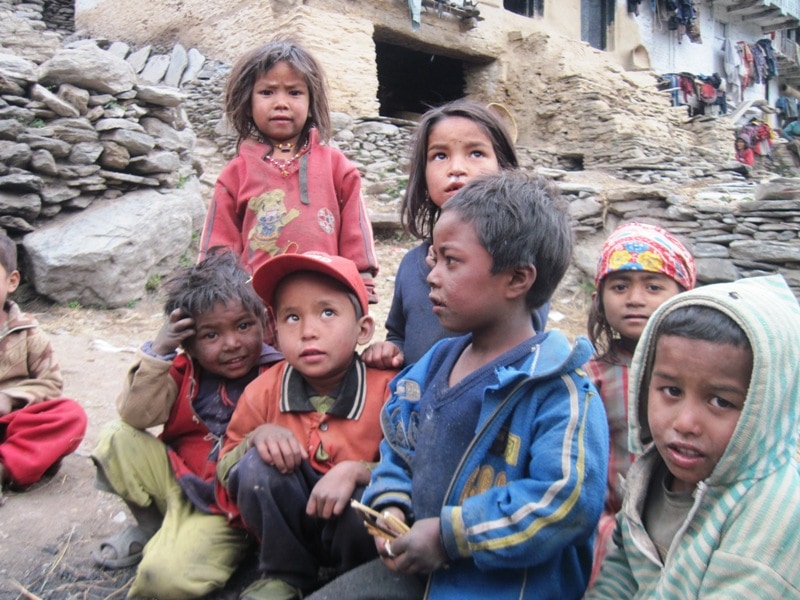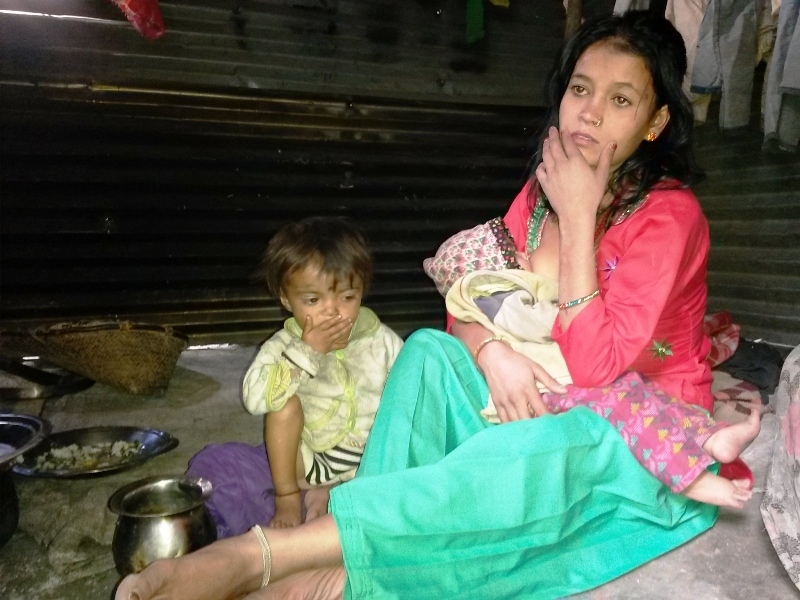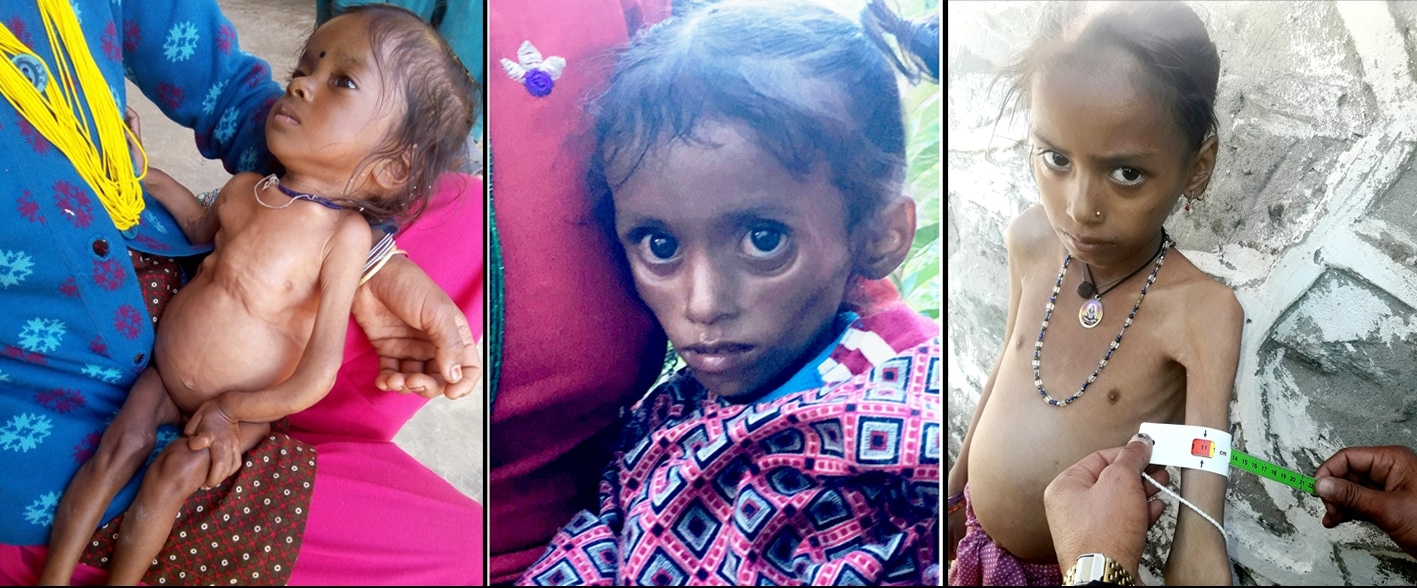In Bajhang district alone, nearly 11,000 children have been afflicted by severe acute malnutrition. The plight of girls is more worrisome
– Basanta Pratap Singh, Centre for Investigative Journalism-Nepal
Twelve-year-old Manju Dhami of Talkot Rural Municipality (the erstwhile Dhamena VDC Ward No 1) died on February 21 this year. Eleven days later, her sister Kalpani Dhami, 10, also breathed her last.
Their mother Parbati Dhami knew too late–a month before the youngest girl died–that the cause of her daughters’ ailment was acute malnutrition.

Children playing in mud.
“Both of them had been weakened for the past one year. Then their belly started bulging out. Their bodies got slender like staffs. We had been tired of visiting shamans and giving them medicinal herbs,” said the mother. “X-ray examination in the district failed to diagnose their problem. After check-up at the Melbisauna Health Post later, they were given medicine for malnutrition, to no avail.”
Manju went to the local school, where she always topped the class. Having finished Grade 4 final exams, she was ready to begin the fifth standard. Her younger sister had passed the second grade. The nutrition out-patient department at the health post had diagnosed severe acute malnutrition in them.
The health facilities did not have the medicine given to malnourished children over five. So the two girls were given the “ready for use therapeutic food” normally provided for malnourished children under five. “By then, both had been unable to eat food. They had eaten only a couple of pouches [of the nutritional supplement] before death,” said Parbati.
These cases are not new. Four months before the twin deaths, records at the District Health Office show, four-year-old Karishma Kunwar of Khiratdiki in Bungal Municipality had succumbed to severe malnutrition. Three-year-old Asmita Japrel of Durgathali Rural Municipality died from similar deficiencies.
The cause of the fatalities was known since all the four girls had come in contact of the Integrated Management of Acute Malnutrition (IMAM) programme run by the District Health Office (DHO). Health workers believe that many other children who have no access to health centres die of acute malnourishment.
“In medical terms, malnourishment does not kill. But we have found that malnourishment is linked with deaths of children,” said Dr Anup Regmi, chief of the DHO. “Malnourishment diminishes immunity. Diseases attack easily and are hard to cure. This leads to death.”
Dr Regmi says the number of malnourished children could be much higher than estimates. According to the National Demographic Health Survey-2016, child mortality per thousand in Bajhang is 39 (under 5 years), 32 (under 1 year) and 21 (under 28 days).
Among the 23,377 children examined by the IMAM programme in the fiscal year 2016/17 in Bajhang, 3,511 were diagnosed with acute malnourishment. As many as 2,266 of them had medium acute malnourishment while 1,245 were found to have severe acute malnourishment, according to programme coordinator Sandesh Rajthala.
The population of under-14 children in Bajhang is 64,123. Since all of them have not been examined, the exact number of malnourished children cannot be ascertained. But health workers estimate that more than 11,000 children are at the risk of acute malnourishment.
Severe acute malnourishment is the most dangerous type of malnourishment. “Without timely care and treatment, severely malnourished children risk losing life any time,” said Dr Regmi.
There are other kinds of malnourishment: chronic malnourishment (stunting), acute and chronic malnourishment (underweight) and micronutrient deficiency. Even as the exact data of children suffering micronutrient deficiency is unavailable, 47 per cent children are found to be stunted while 29 per cent are underweight in Bajhang, the DHO records show. According to the NDHS-2016, 39.3 per cent children are anaemic.
Girls at greater risk
“Had they been sons, sisters Manju and Kamala would probably not have died prematurely from malnourishment,” Assistant Health Worker at Talkot Health Post Janak Kumar Bista said. “If their son falls sick, [people] treat him even by borrowing money. [They] take them to Dhangadhi, Kathmandu. When their daughter is ill, [they] don’t even take her to the [district] headquarters,” Bista remarked. Had Manju and Kalpana, who faced malnourishment for 13 months, been taken to a well-facilitated health centre on time, they would have survived undoubtedly, said Bista.

Badi women of Bajhang who had already given birth to three children at the age of 17.
All the four children reported to have died of severe malnutrition in the past year are girls. Besides, health workers believe, those who die in the lack of treatment or the fatalities that do not come to public notice involve girls mostly.
An incident in the family of Shanti Japrel in Sainapasela Waikot of Durgathali Rural Municipality explains this. The nutrition officer from the DHO, who visited their house, found that three-year-old Asmita had severe malnutrition. He asked the family to admit her to the nutrition rehabilitation centre of the district hospital promising free treatment.
Shanti did not follow the health workers’ advice saying that she had already spent 15 to 20 thousand rupees on her daughter’s “treatment” from local healers and shamans. She said she had no hope for her daughter’s cure. Shanta argued that there would be nobody from the family to care for the girl at the nutrition centre since she had to take care of her father-in-law and two sons at home. Her husband had been working in Malaysia for the past four years. Shanta ultimately admitted Asmita to District Hospital Bajhang after nutrition officer Indra Karki threatened to report the case with the police.
After two days at the hospital, Shanta had left along with her daughter on the pretext of having some snacks outside, never to return. When hospital staff found the admitted patient missing, they asked the police to look for her. Later they were found to have reached home.
“Household chores had piled on due to my stay at the hospital for three days,” Shanti said without regret. “The old father-in-law is unable to handle things. I fled the hospital leaving it to her fate. She died the other day.” Shanta said she had hesitated to take her to hospital as “I was sure that she would die.”
Last December, malnutrition claimed the life of four-and-a-half year old Karishma Kunwar of Khiratadi VDC. Health workers had told the family that the girl needed treatment but her guardians said they could not afford to be with the child at the hospital for weeks abandoning work at home. “The family turned down our suggestion. The girl died helplessly,” said Sunil Gajurel, a former official at the malnutrition response programme of the DHO.
It takes two hours to half-a-day on foot to reach the district hospital from the places where these incidents happened. Strangely, three daughters of Tulsi Nepali at Rithapakha, which is 500 metres from Simkhet where the district hospital is located, are also suffering from chronic malnutrition. Among the siblings, two-year-old Saraswati has life-threatening malnutrition. Health workers have reached the family several times to request them to treat the baby. A defiant Tulsi says, “My oldest son was like her as a baby. He’s now earning in India. The health officials press me every day to admit her to hospital as they get paid in our name. I’ve scolded them but they haven’t stopped coming.”
Nutrition officer at the DHO Sabita Shahi Thakuri agreed that Tulsi often shouted at them when they prodded the woman for her daughter’s treatment. “Tulsi answers angrily that we needn’t worry if her daughters died. The baby has pitiable condition. She doesn’t listen even to doctors,” said Sabita.
According to DPO Bajhang, the number of children having moderate to severe acute malnutrition in the district is 3,511. The lives of most of them are in peril since their parents are not ready for their treatment.
“I had not imagined this level of discrimination between son and daughter,” says Dr Sunil Gajurel. “The treatment is free. They refuse to come for their daughter’s treatment even when we promise food and accommodation for the attendant as well. They reply that they can always give birth to another if one dies.”
In rural areas, people even today take malnourished children to local healers and witch doctors rather than hospital and apply monkey faeces on their body believing it to be bandre (sickle cell anaemia), said Gajurel.
Surveys have shown that food shortages, illiteracy, superstition and unsafe food are the main causes of malnutrition. More than half of the malnourished children are girls while lack of treatment caused by discrimination between the sexes threatens lives mostly of girls, according to Dr Gajurel. “We provide treatment cost for patients who cannot be treated in the district. They are not ready to take patients away for treatment. Most produce excuses of pending household chores. Most malnourished girls are dying at early ages,” he said.
Girl children are malnourished mainly due to discrimination in food and care at home. Dalit Women Association Chairperson Asha BK says, “When a son is born, the mother is given good food and is loved. When a girl is born, the postpartum woman does not get nutritious food and care. Since their mothers face discrimination after their birth, severe malnutrition is more prevalent in girl children.”
Fund flood can’t flush malnutrition
This scary picture of malnutrition in Bajhang does not mean that there is no organisation working to end the menace in the district. Statistics show that government and non-government organisations spend nearly Rs500,000,000 in total annually on programmes aimed at improving the nutritional situation, awareness raising and behavioural changes.

Untimely death of Manju Dhami of Dhamena due to severe malnutrition.
In the fiscal year 2016/17 alone, Rs 80 million was spent under the agriculture and food security programme, Rs 11.2 million by Suahara programme for pregnant women and those rearing a child younger than 1,000 days, Rs 11.4 million for integrated multi-regional nutrition programme, Rs 3,050,000 for the Pahal programme and Rs 300 million for child nutrition allowances.
The DHO spent Rs 70 million on Vitamin A programme, anti-worm drugs and integrated child health programme. Besides, INGOs such as USAID, Practical Action, Care Nepal, Save the Children and Helen Keller International have invested heavily for improving the state of nutrition in the district. Spending by United Nations arms under the UN Development Programme Unicef, UFO, UNFPA and World Food Programme is also huge.
From the government’s side, expenditures under the District Health Office, the Women Development Programme, the District Agriculture Development Office, the District Education Office and the local level for providing nutritional support are hefty too. All the offices have reported that more than 90 per cent of their total fund was spent on ‘awareness raising on nutrition.
Hemanta Shahi, coordinator of the Multi-sectoral Nutrition Programme of the District Coordination Committee (DCC), says, “We cannot say there hasn’t been any progress. There has been much improvement comparatively. But the outcome has not been satisfactory considering the investment.” He believes that programmes on malnutrition control have failed to achieve the desired outcomes since plans are made based on the desires of NGOs and central agencies, rather than local needs.
Women’s suffering
Malnutrition is rampant in Bajhang district even in women of reproductive age. According to the NDHS 2016, 39.2 per cent women of reproductive age have anaemia.
According to the report, 23,880 among the 61,232 women in the age group 15-49 years are anaemic. According to the DCC data, child marriages in the district account for 65 per cent of all marriages. Babies born to underage and malnourished women are more likely to face malnutrition.
Shahi said there is no end to the vicious cycle of malnutrition that attacks the baby from the womb when the expecting mother is malnourished. As a remedy, proper foods should be given since conception until the baby is two years old. This is a major challenge in the district.
DHO chief Dr Regmi says malnutrition affects not only the foetus but the mother too. Anaemic women face more risks during pregnancy and childbirth. “Due to anaemia, women have a great risk of losing life during delivery,” said Dr Regmi. “Compared to normal people, these women are attacked by diseases more often.”
Causes of malnutrition
The main cause of malnutrition in Bajhang is shortage of foodstuff. According to the District Agriculture Development Office, the annual food grain shortfall in the district is 11,000 tonnes. The 11million kg food deficit for nearly 200,000 people accounts for a shortage of 55kg per person per annum.
In a district with nearly 90 per cent people engaged in agriculture, relentless work is another cause of malnutrition. Since women are busier with farm jobs than men, they cannot spare enough time for nutritional care and sanitation of themselves and their children.
“Pregnant women here take more care of pregnant cattle than themselves,” said Shahi of the Multi-sectoral Nutrition Programme. “Women are physically fragile. Since they also toil hard and pay little attention to what they eat, both mother and child are found to be malnourished.” A major factor for malnutrition in children under five is their mothers remaining too busy on the field to breastfeed infants or to care for them.

Death of children due to severe malnutrition. Ashmita Japrel of Sainpasela, Karishma Kunwar of Khiratadi and Kalpana Dhami of Dhamena.
Superstition has also been blamed for the nutrition deficiency. Since the woman and her newborn are kept out in the Chhau shed for the first 21 days, infants and their mothers are troubled by cold and smoke. Wrongly believing that greens, pulses, yoghurt, milk, fish and meat cause loose motion in the baby, the mother and the infant are denied nutritious foods since early on, imperilling their health.
Another cause of malnutrition is child marriage. Since girls are married in their teenage and bear children without proper birth spacing, neither the mother nor the baby are properly looked after, leading to malnourishment in children.
Illiteracy in women is also blamed for the poor state of nutrition. “The state of health and sanitation in children is comparatively better in families where the woman is educated,” says Bimala Bista, facilitator for the agriculture and food security programme. “Most children from homes where the woman is illiterate are malnourished.”
According to the DCC data, about 73 per cent males are literate in the district while the literacy rate for women is only 40 per cent. Since highly nutritious grains like millet, foxtail millet, buckwheat and oats have fallen out of favour due to beliefs that only “low class” people consume them, their cultivation has now been rare. Experts in the region say that a lack of diversity in food consumption due to the regularity of rice-roti intake has led to a deficiency of nutrients in the body.



